�
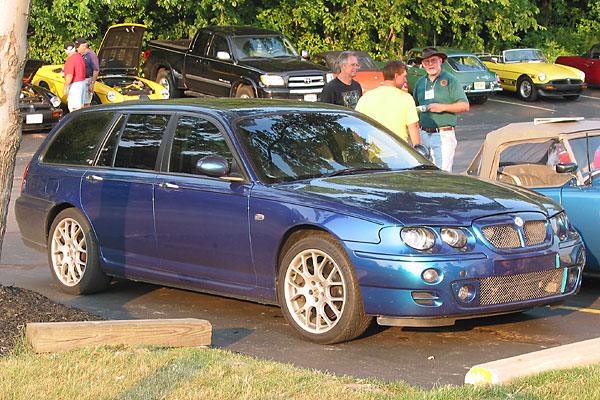
�
The Triple-C Motor Accessories MG ZT-T 260 V8 as photographed at British V8 2007 �
Philip Cooke's 2006 MG ZT-T 260 V8 (with Ford 4.6L V8 engine)
� as published in British V8 Newsletter, Volume XV Issue 2, September 2007�� Owner: Philip Cooke of Triple-C Motor Accessories
� � City: York, PA
� Model: MG ZT-T
� Engine: Ford 4.6L V8 engine
� Specifications:
�
| Engine: | �Ford 4.6L V8, rated at 260bhp at 5000rpm & 302ft.lb at 4000rpm. Single overhead cam. �
Two valves/cylinder. | �
| Induction: | �sequential multipoint electronic fuel injection. | �
| Transmission: | �Tremec TR3650 5-speed manual, with hydraulic clutch. | �
| Front Susp.: | �Eibach linear-rate springs and Bilstein McPherson struts. Anti-roll bar.�
Power rack-and-pinion steering. | �
| Rear Susp.: | �multi-link, with a six-mount subframe that houses a Dana Hyrdratrak �
limited-slip differential. Each wheel is located by three lateral links �
(two steel and one alloy) and an alloy trailing arm. Compound-rate �
Eibach springs. Bilstein shocks. Anti-roll bar. According to MG Rover �
press releases, the rear suspension was developed specifically for the �
ZT 260 V8, but other reports suggest that the design was sourced from �
GM's Holden division (in Australia) Some reports indicate that BMW �
half-shafts were used. | �
| Brakes: | �(front) AP-Racing 325mm ventilated discs and sliding-pin calipers � (rear) AP-Racing 332mm ventilated discs and opposed-piston alloy calipers. � (Note: the rear rotors were special to this model, and aren't available otherwise.) | �
| Wheels/Tires: | �18in "Straights" multi-spoke alloys with Contisport 225/45 ZR18 tyres | �
| Weight: | �approximately 1779kg (3890 pounds). | �
| Performance: | �maximum rated speed = 155mph. 0-60mph in 6.2 seconds. 21.5mpg average/estimated. | �
| Electrical: | �Xenon headlights. | �
| Optional Equipment: | �The chromatic paint job on this car was a special $4500 option. It's designed to �
change color depending on the angle of sunlight hitting it. Other interesting �
factory options were the (1) Xenon headlights, (2) Harman/Kardon sound system �
and (3) a BMW-sourced in-dash navigation/television system. (The television only �
functions when the car is stationary.) | �
Background Information:
��
The MG ZT (sedan) and ZT-T (wagon) models were the flagship sporty vehicles of "The MG Rover Group". �
�
Since many of our readers aren't very familiar with the lineage that led to these vehicles, we'll �
summarize it quickly here: British Leyland Motor Corporation (BLMC) was the company that owned and �
operated MG, Triumph, Austin, Rover, etc. through the 1970's. When they collapsed and were nationalized, �
the company name was shortened to just British Leyland and car operations were dramatically consolidated. �
The MG Abingdon plant was closed and its products were discontinued. British Leyland continued to put �
MG badges on some vehicles, including the "Metro" and "Maestro" sporty subcompacts. In 1986, British �
Leyland was renamed Rover Group. In 1988 they were absorbed by British Aerospace. Under this ownership, �
Rover Group offered the MG RV8 and also developed and launched the MGF. In 1995 Rover Group were �
bought from British Aerospace by BMW. �
�
Under BMW ownership Rover engineers developed the Rover 75 model cars (as well as the new Mini). �
Since BMW was paying the bills, and they didn't want the Rover 75 to compete with their own BMW �
models, the Rover 75 was deliberately positioned as "conservative" in styling and performance. �
In 2000 BMW split Rover into three parts, keeping the most lucrative (Mini) part for itself. �
Range Rover went to Ford. Rover's remaining car products and facilities (including the old Austin �
plant at Longbridge) were spun-off to become The MG Rover Group. �
�
History will record that The MG Rover Group made a pretty valiant effort. After being split from BMW,�
the company developed and launched highly-regarded sporty versions of the Rover 75 within just one �
year. As originally introduced, the MG ZT and ZT-T were essentially Rover 75 cars with face-lifted �
styling and with up-rated suspensions. The company needed a real "flagship" model, and for that they �
needed a bigger, stronger engine than they could produce in house. To create a V8 engine option, �
the company worked with an outside engine manufacturer, outside engineering firms, and they �
had to substantially modify the Rover 75 / MG ZT chassis. The drivetrain, suspension, and braking �
systems for the new "ZT 260 V8" models were brand new, and the body featured significant modifications.�
�
Enjoying this article? Our magazine is funded through the generous support of readers like you!
�
To contribute to our operating budget, please click here and follow the instructions.
�
(Suggested contribution is twenty bucks per year. Feel free to give more!)�
Philip Cooke's MG ZT-T 260 V8
��
Philip's car was actually produced very, very early in the ZT 260 V8 model program. According to �
Longbridge records, the body was the 23rd stamped. Philip's car was originally registered in England �
as a 2003 model, and it was assigned to the MG Rover Group press office at Longbridge. But it apparently �
didn't stay there long! Ownership was transferred to one of MG Rover's key development partners, Roush �
Industries in Livonia Michigan (a Detroit suburb, and yes that's Roush as in "Jack Roush".) Roush used �
the car for various engineering purposes. Interestingly, they titled the car (in Michigan) as a 2006 �
model even though MG Rover Group actually ceased all production and went into bankruptcy on April 15th, 2005. �
�
It's a great pity that MG Rover Group ran out of money just as they were hitting their stride in �
terms of product offering. Only about 700 MG ZT-T 260 V8 cars were ever produced. A former MGB V8 owner�
himself, Philip reports that his ZT-T is a great driving car with a very willing engine. The car �
is as comfortable cruising at 85mph as it is idling in the driveway. When the car does need service, �
the drivetrain components are all readily available and familiar because they're basically standard �
Ford parts - right down to the subtle Mustang emblem cast into the top of the throttle body assembly! �
�
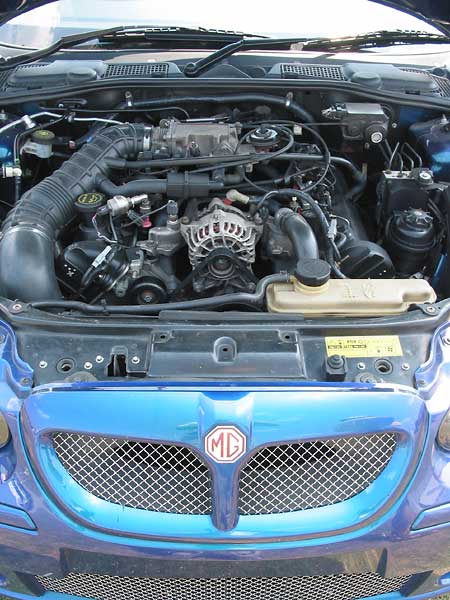
�
Ford 4.6L V8 engine, rated at 260bhp at 5000rpm and 302ft.lb at 4000rpm.
�
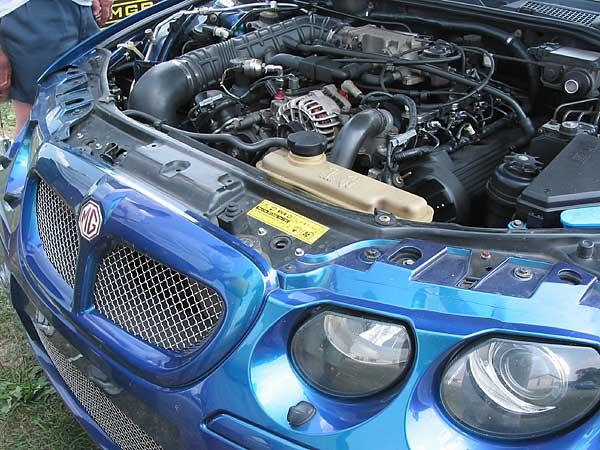
�
Xenon headlamps and distinctive stainless steel mesh grille
�
�
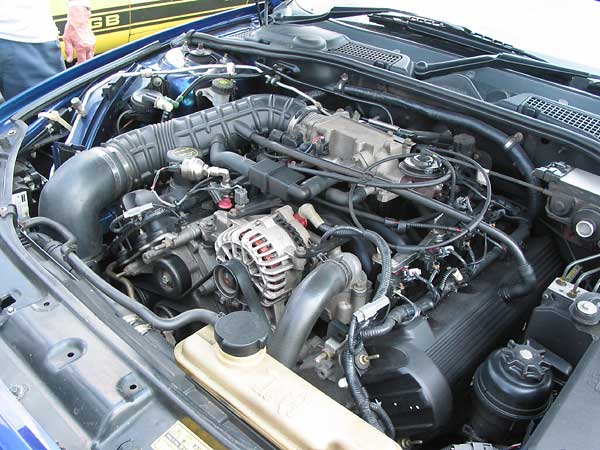
�
Coincidentally, in the background here you can just see Jack Renaud's MGB. Jack is a retired Ford engineer.
�
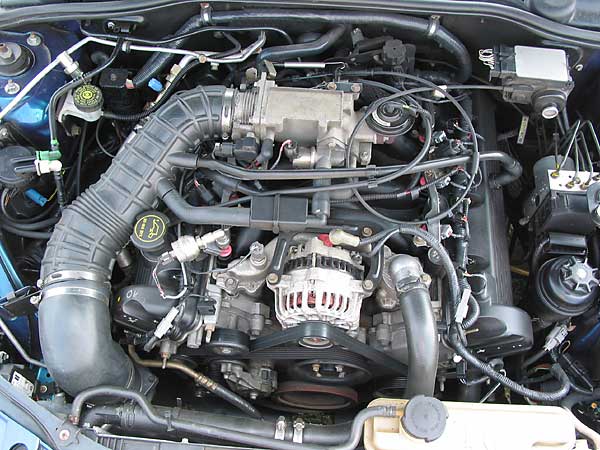
�
Philip reports there are a few extra sensors and wires on the engine, left over from its time at Roush Industries. �

